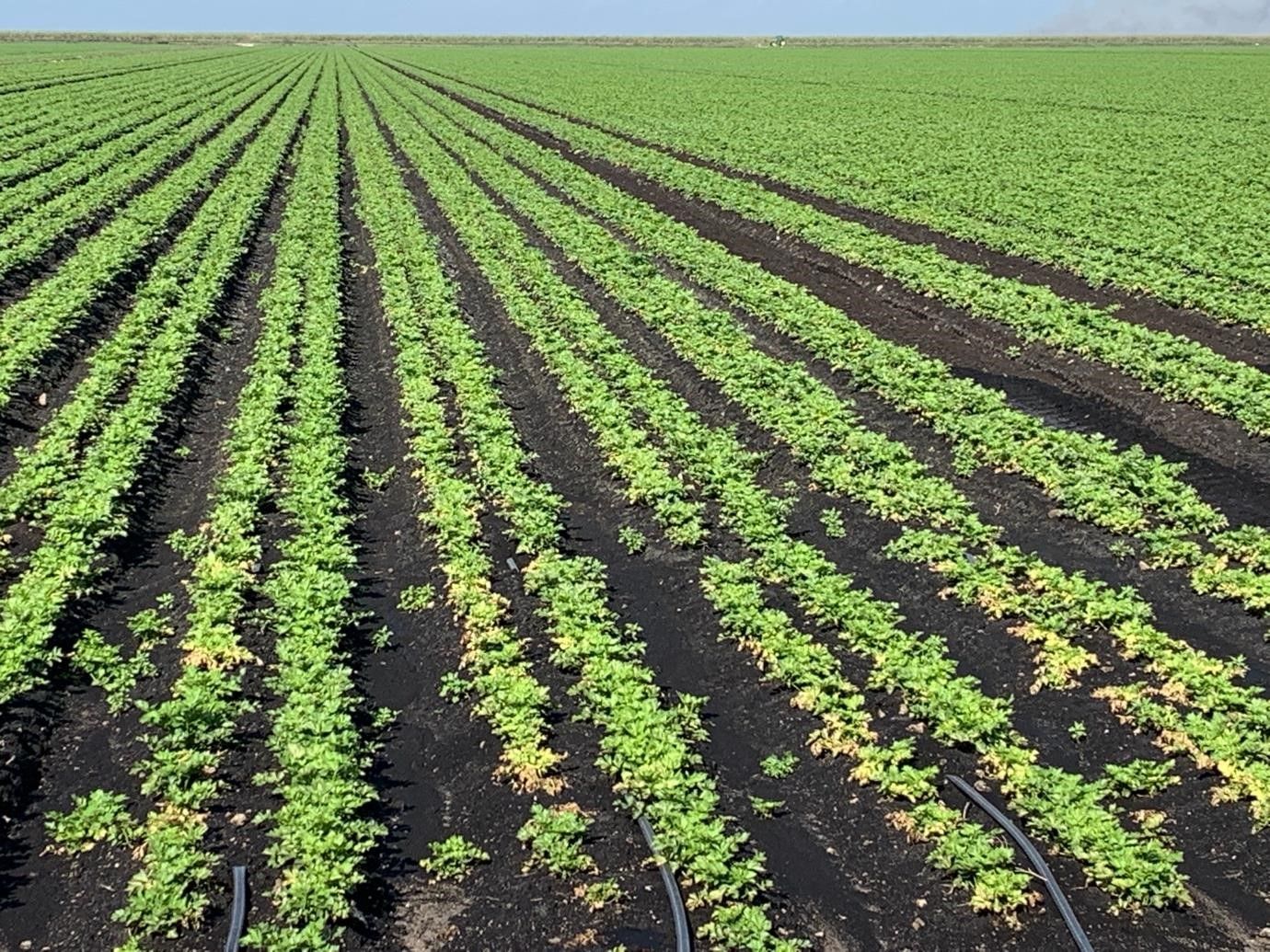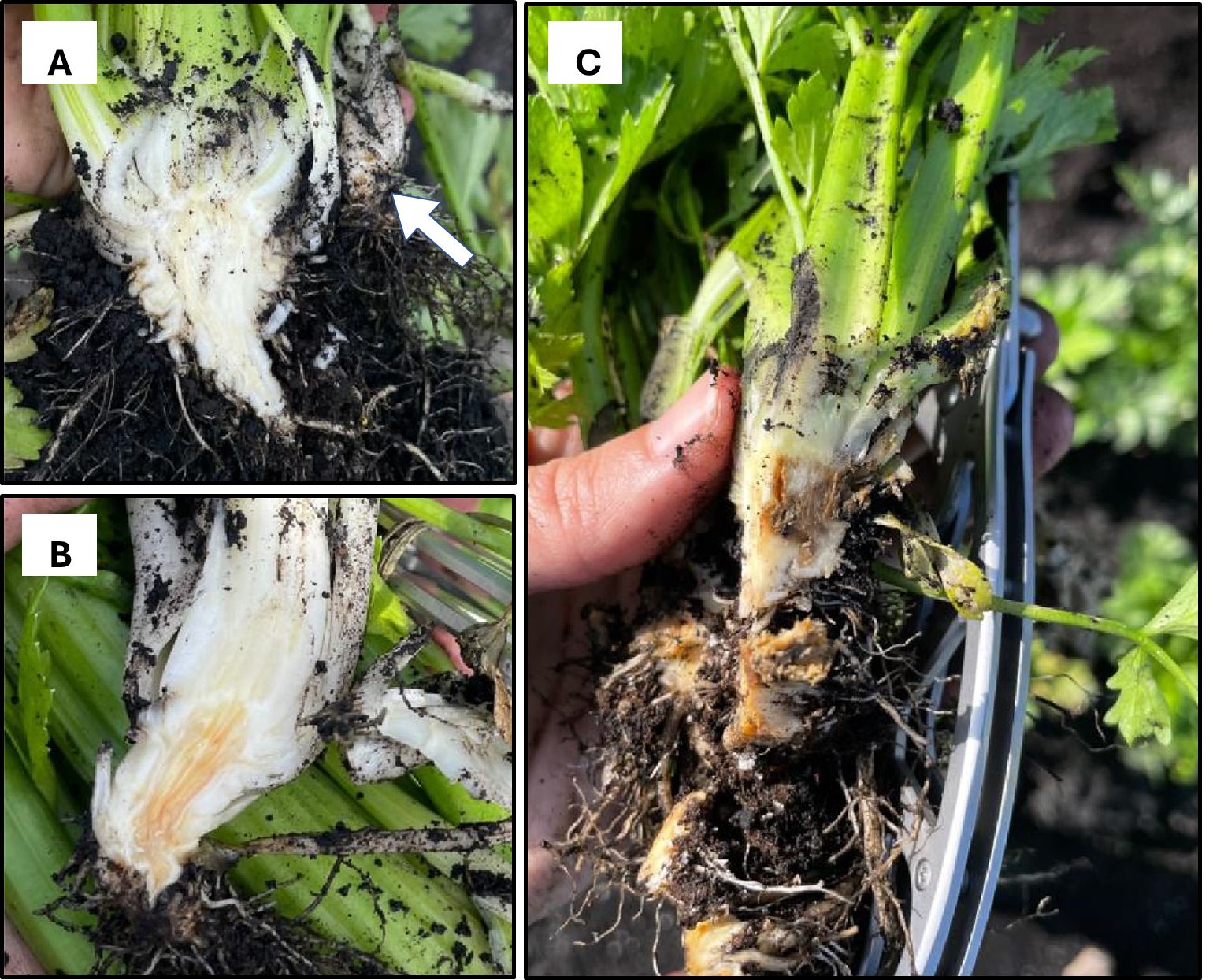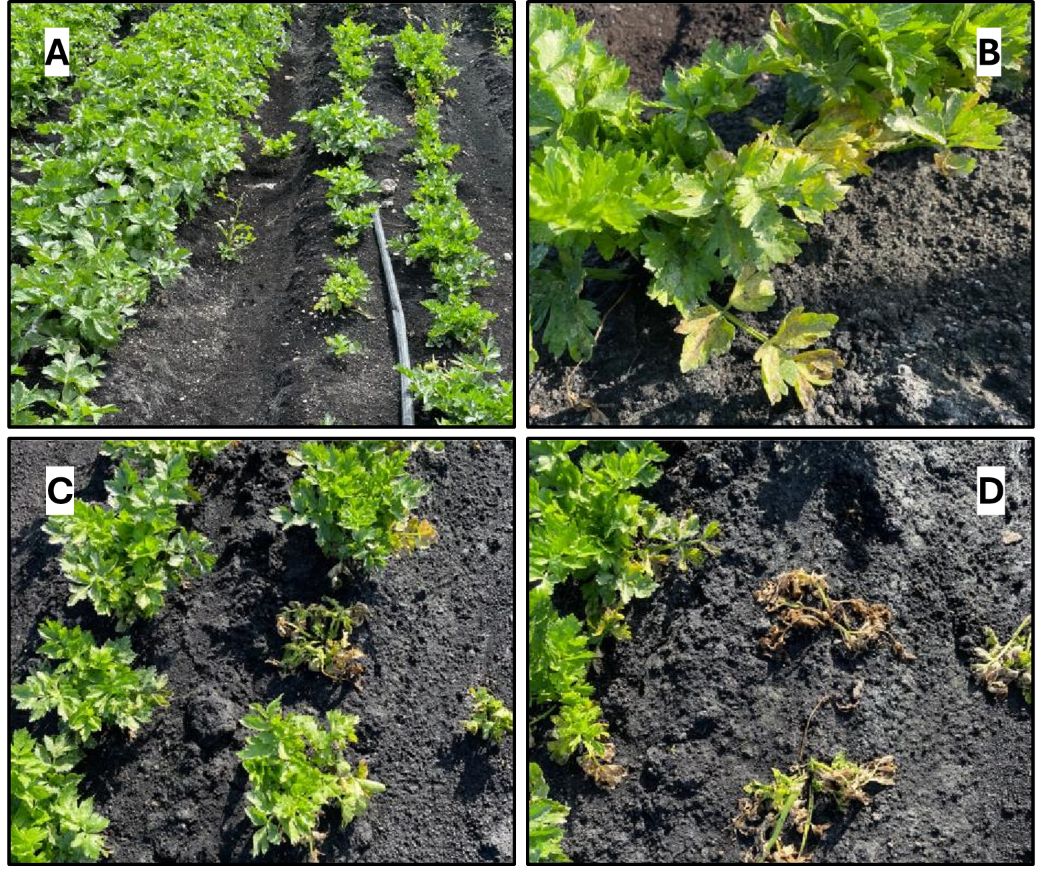Fusarium Wilt on Celery
Celery (Apium graveolens L.) is produced in south Florida on approximately 1,500 acres yearly and includes both conventional and organic production systems. Fusarium wilt, caused by Fusarium oxysporum f. sp. apii (Foa) race 4, emerged as a significant threat to celery production in the Everglades Agricultural Area (EAA) in Florida in 2022 (Ferreira Jr. et al. 2024). Since it was first reported in the United States in Michigan in 1914, Foa has evolved into four different pathogenic races. While Foa was initially detected in Florida in 1984, no information was provided regarding the specific race present at that time (Alfieri et al. 1984). In 2013, the most virulent race, Foa race 4, was first reported in California (Epstein et al. 2017), and since then, it has been causing substantial losses to celery growers. In 2022, Foa race 4 was confirmed for the first time in Florida. This confirmation was achieved through PCR analysis using primers specific to race 4, as well as molecular phylogeny (Ferreira Jr et al. 2024). The first occurrence in south Florida is critical and alarming because (1) race 4 is the most virulent among the four races, (2) there is a lack of effective chemical and varietal control options for EAA Florida growers, and (3) this pathogen can survive in the soil for many years. This publication provides novel information to growers, Extension agents, and crop consultants of the celery industry in Florida regarding disease identification and management.
Celery Production
In the United States, celery production is predominantly located in California, Michigan, and Florida (USDA-NASS 2023). Florida plays a pivotal role in supplying this specialty crop to the United States domestic market, especially during the colder months when northern states are not in production. Approximately 1,500 acres in south Florida are dedicated to celery cultivation yearly, with approximately 10% of this acreage managed using organic production practices (Katia Viana Xavier, personal communication, 2023). Celery growers in this region implement diverse cultural practices to manage pests and diseases, including crop rotation and location, plant spacing, and consideration of wind direction. However, crop rotation in south Florida, particularly involving sugarcane, rice, and winter vegetables, can risk spreading soil-borne pathogens like Foa. Additionally, machinery can actively spread pathogen propagules within and between fields, regardless of the crop under cultivation. Therefore, it is essential for both celery growers and those cultivating other crops in the region to be aware of this potential hazard and implement appropriate preventive measures.
Celery growers have adopted specialized cultural practices, machinery, and harvesting techniques to ensure the production of high-quality, visually appealing, and marketable celery that meets consumer demands. However, plants affected by Fusarium wilt exhibit symptoms of stunting and yellowing and can die quickly, directly impacting their marketability and resulting in partial or total yield losses (Figure 1).

Credit: Anna Mészáros, UF/IFAS
Disease Symptoms
Fusarium wilt caused by Foa race 4 observed in Florida is characterized by typical vascular discoloration in the roots and crown compared to an asymptomatic plant (Figure 2A–C). In young plants, this disease is manifested as brown discoloration of the vascular system or crown (Figure 2B), which can progress to dark brown symptoms (Figure 2C).

Credit: Katia Viana Xavier, UF/IFAS
Fusarium wilt caused by Foa race 4 is also characterized by the yellowing of lower leaves (Figure 3B). Fusarium oxysporum f. sp. apii induces stunting (Figure 3A) and wilting of the whole plant (Figure 3A and C). Under favorable conditions and host susceptibility, these symptoms lead to the death of celery plants (Figure 3D).

Credit: Katia Viana Xavier, UF/IFAS
Disease Cycle
When celery transplants are planted into infested soils, the root tips function as the major entrance points for Foa. After successful infection and colonization of the roots, the pathogen moves upwards within the plant’s vascular system, colonizing the crown. Discoloration symptoms within the vascular system can be visible by splitting the stem, and yellowing of the lower leaves can also be observed. Secondary roots may emerge and serve as new infection sites, contributing to a worsening of Fusarium wilt (Hart and Endo 1981). In south Florida, diseased plants and plant residues are incorporated into the soil after harvesting, where the pathogen can survive for several years. Fusarium wilt development caused by Foa race 4 favors temperatures between 22°C and 26°C (72°F to 79°F), with increasing temperatures resulting in a higher disease severity (Kaur et al. 2022). Consequently, Florida’s warm climate increases the risk posed by Foa race 4 during the entire growing season. In the EAA, flooding the fields is a common off-season practice used to protect the organic soils (Stephens 1956). However, growers should be aware that Fusarium wilt incidence has been reported to be higher in flooded fields than in non-flooded ones, particularly in crops like lettuce (Matheron and Porchas 2010).
The specific long-distance dissemination and host range of Foa race 4 remain to be determined, but we can draw parallels with other pathogenic formae speciales of Fusarium oxysporum. Dissemination can occur via wind, humans, and farm machinery by moving soil or crop debris from infested areas into non-infested areas. Pathogen propagules can also be disseminated via contaminated seed and seedlings (Garibaldi et al. 2004; Bennett et al. 2008). Furthermore, propagules of Foa can survive in the soil and crop residue for several years (Elmer and Lacy 1987). Foa has also been reported to colonize roots of barnyard grass (Echinochloa crusgalli L.), cabbage (Brassica oleracea L.), lamb’s-quarters (Chenopodium album L.), onion (Allium cepae L.), smartweed (Polygonum pennsylvanicum L.), sweet corn (Zea mays L.), and purslane (Portulaca oleracea L.) (Elmer and Lacy 1987).
Fusarium Host Specificity
Members of Fusarium species include ubiquitous, vascular, disease-causing fungi with a distinctively broad host range, especially Fusarium oxysporum, making them one of the most important plant pathogens worldwide. Isolates of F. oxysporum can infect monocots (e.g., onion, corn, and wheat) and dicots (e.g., celery, lettuce, and strawberry). Only specialized forms of F. oxysporrum are able to infect a specific plant host. These specialized forms are taxonomically referred to as forma specialis (f. sp.). For instance, F. oxysporum f. sp. apii causes disease on celery but is unable to cause disease on lettuce. Likewise, F. oxysporum f. sp. lactucae causes disease on lettuce but not celery. Some formae speciales, such as F. oxysporum f. sp. apii, are further classified into races depending on their ability to cause disease on a specific cultivar of a given host. For instance, Foa race 2 causes Fusarium yellows on celery ‘Tall Utah 52-70R’ but not on ‘Challenger’, while race 4 infects both cultivars. Given that many modern celery cultivars are closely related to ‘Challenger’, the emergence of Foa race 4 in Florida presents a significant threat to the industry, raising the urgent need to develop and implement effective management practices for Fusarium wilt disease.
Challenges Posed by Race 4
A specific race of Fusarium oxysporum is generally able to cause disease in only certain cultivars. For example, Foa race 1 causes disease only in heirloom or yellow-type cultivars (Apium graveolens var. dulce), whereas race 2 infects green-type cultivars (e.g., ‘Tall Utah 52-70R’). The cultivar ‘Challenger’ is resistant to Foa races 2 and 3. However, it has been reported that Foa race 4 is able to infect the celery cultivars ‘Challenger’ and ‘Tall Utah 52-70R’ as well as cilantro (Coriandrum sativum) (Epstein et al. 2022). Ferreira Jr. et al. (2024) recently reported that Foa race 4 can infect two varieties of parsley, another member of the Apiaceae. Consequently, the promiscuous nature of Foa race 4 represents an unprecedented challenge for managing Fusarium wilt (Epstein et al. 2022) and may require new management strategies.
Foa can colonize and survive on alternative hosts, but pathogen multiplication on these hosts has not been documented so far. However, these alternative crops may still contribute to the survival of Fusarium wilt pathogen by affecting inoculum loads in the field. In south Florida, sweet corn is often grown in rotation with celery. Thus, it becomes important to evaluate the survival and multiplication of Foa race 4 on sweet corn and other rotational crops grown in the EAA. In addition, increasing seasonal temperatures may also result in increased severity of Fusarium wilt, threatening celery production in south Florida.
Management Strategies
Controlling soil-borne phytopathogens is a significant challenge, as is the case with Fusarium wilt in celery. The primary focus is preventing its introduction by using seed and seedlings from certified nurseries. If Foa infestation is suspected, contact your local Extension agent or specialist for assistance as molecular testing is required for race 4 diagnosis.
Once the presence of the pathogen is confirmed in celery plants, management should focus on reducing its dissemination within and between fields. It is recommended to cultivate celery first in pathogen-free areas on the farm before those that are infested. When moving from an infested area to a noninfested area, it is crucial to remove soil from and disinfest machinery, truck tires, and worker shoes. Although the use of resistant celery cultivars is the primary management strategy in infested areas, there are limited options of cultivars currently suitable for Florida production that carry Foa race 4 resistance. Unfortunately, most of the commercially grown celery cultivars are susceptible to Foa. Therefore, crop rotation with non-host crops plays a crucial role in reducing Foa inoculum in infested areas. Avoid growing alternative hosts such as sweet corn, cilantro, and parsley in infested areas to help prevent pathogen buildup. Additionally, excess moisture in the soil favors disease infection; fields should not be over-irrigated. Irrigation water and equipment must be free of pathogen propagules. Foa race 4 is highly aggressive at temperatures above 22°C (71.6°F) (Kaur et al. 2022), thus planting celery during cooler periods reduces disease development. Despite the absence of registered fungicides against Fusarium oxysporum in celery, these cultural management strategies can help mitigate its impact.
Concluding Remarks
The presence of Foa race 4 threatens celery production in Florida due to its highly aggressive nature and ability to survive in the soil for several years. There is a pressing need for research to determine if crops used in rotation can host this new Foa race and how they can affect inoculum levels. Such alternative hosts may contribute to the survival and buildup of inoculum, potentially increasing the risk of disease outbreaks in subsequent celery crops. Additionally, efforts should be focused on developing resistant cultivars to tackle this pathogen effectively and sustainably.
References
Alfieri Jr., S. A., K. R. Langdon, C. Wehlburg, and J. W. Kimbrough. 1984. “Index of Plant Diseases in Florida (Revised).” Florida Department of Agriculture and Consumer Services, Division of Plant Industries Bulletin 11: 1–389.
Bennett, R. S., R. B. Hutmacher, and R. M. Davis. 2008. “Seed Transmission of Fusarium oxysporum f. sp. vasinfectum Race 4 in California.” The Journal of Cotton Science 12: 160–164.
Elmer, E., and M. Lacy. 1987. “Effects of Crop Residues and Colonization of Plant Tissues on Propagule Survival and Soil Populations of Fusarium oxysporum f. sp. apii Race 2.” Phytopathology 77: 381–387. https://doi.org/10.1094/Phyto-77-381
Epstein, L., S. Kaur, P. L. Chang, N. Carrasquilla-Garcia, G. Lyu, D. R. Cook, K. V. Subbarao, and K. O’Donnell. 2017. “Races of the celery pathogen Fusarium oxysporum f. sp. apii are polyphyletic.” Phytopathology 107 (4): 463–473. https://doi.org/10.1094/PHYTO-04-16-0174-R
Epstein, L., S. Kaur, and P. M. Henry. 2022. “The emergence of Fusarium oxysporum f. sp. apii race 4 and Fusarium oxysporum f. sp. coriandrii highlights major obstacles facing agricultural production in coastal California in a warming climate: A case study.” Frontiers in Plant Science 13. https://doi.org/10.3389/fpls.2022.921516
Ferreira Jr., T. A., L. C. Ferreira, V. Silva de Moura, and K. V. Xavier. 2024. “Fusarium oxysporum f. sp. apii Race 4 Threatening Celery Production in South Florida.” Plant Disease. https://doi.org/10.1094/PDIS-01-24-0075-RE
Garibaldi, A., G. Gilardi, and M. L. Gullino. 2004. “Seed Transmission of Fusarium oxysporum f. sp. lactucae.” Phytoparasitica 32: 61–65. https://doi.org/10.1007/BF02980861
Hart, L., and R. Endo. 1981. “The Effect of Time of Exposure to Inoculum, Plant age, Root Development, and Root Wounding on Fusarium Yellows of Celery.” Phytopathology 71: 77–79. https://doi.org/10.1094/Phyto-71-77
Kaur, S., R. Barakat, J. Kaur, and L. Epstein. 2022. “The Effect of Temperature on Disease Severity and Growth of Fusarium oxysporum f. sp. apii Races 2 and 4 in Celery.” Phytopathology 112 (2): 364–372. https://doi.org/10.1094/PHYTO-11-20-0519-R
Matheron, M. E., and M. Porchas. 2010. “Evaluation of Soil Solarization and Flooding As Management Tools for Fusarium Wilt of Lettuce." Plant Disease 94 (11): 1323– 1328. https://doi.org/10.1094/PDIS-04-10-0296
Stephens, J. C. 1956. “Subsidence of Organic Soils in the Florida Everglades.” Soil Science Society of America Journal 20 (1): 77–80. https://doi.org/10.2136/sssaj1956.03615995002000010019x
USDA-NASS. 2023. “Quick Stats.” Accessed on January 14, 2024. https://quickstats.nass.usda.gov/results/8AB68D99-BADE-386A-B7731B6A765E2366